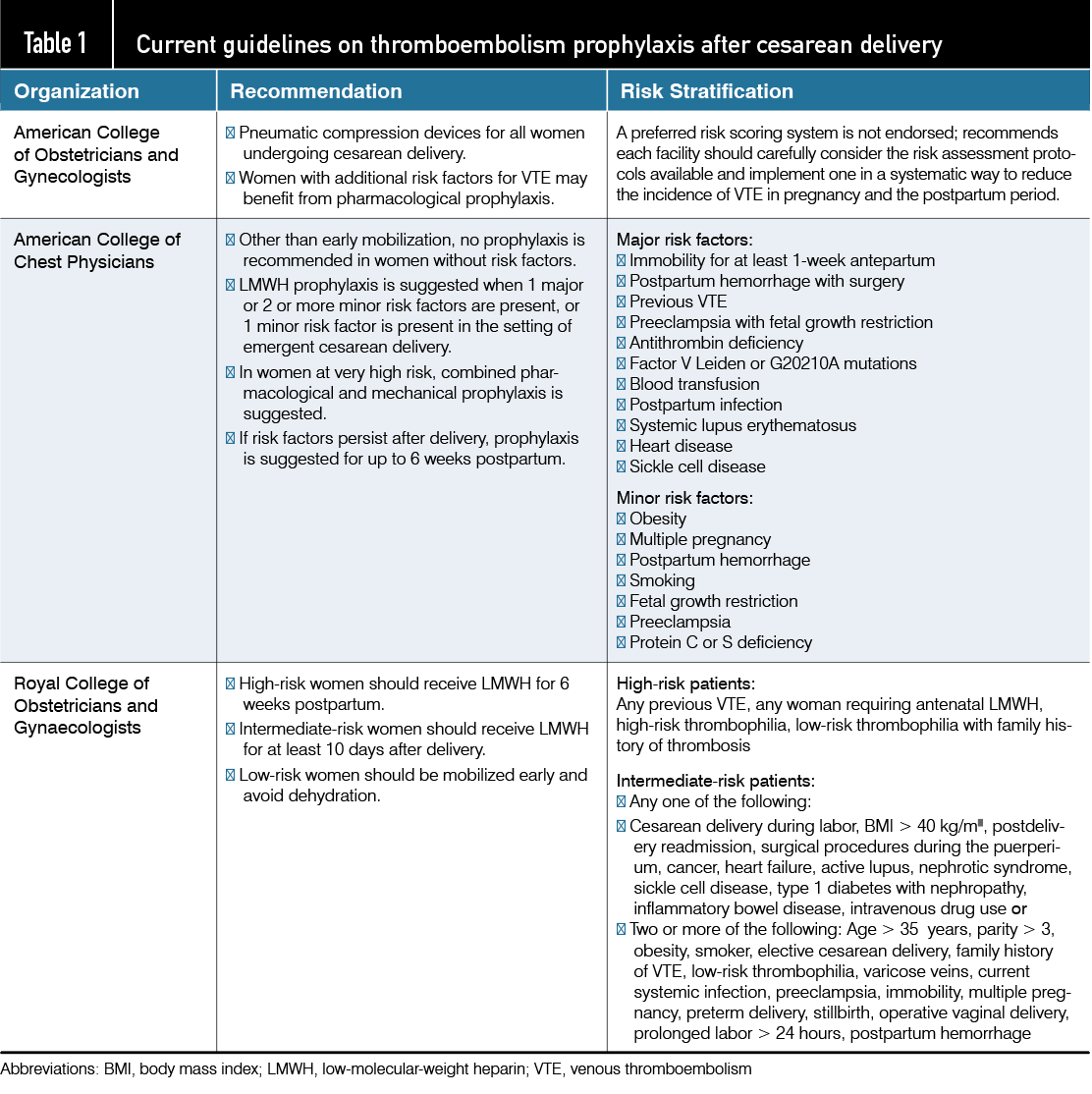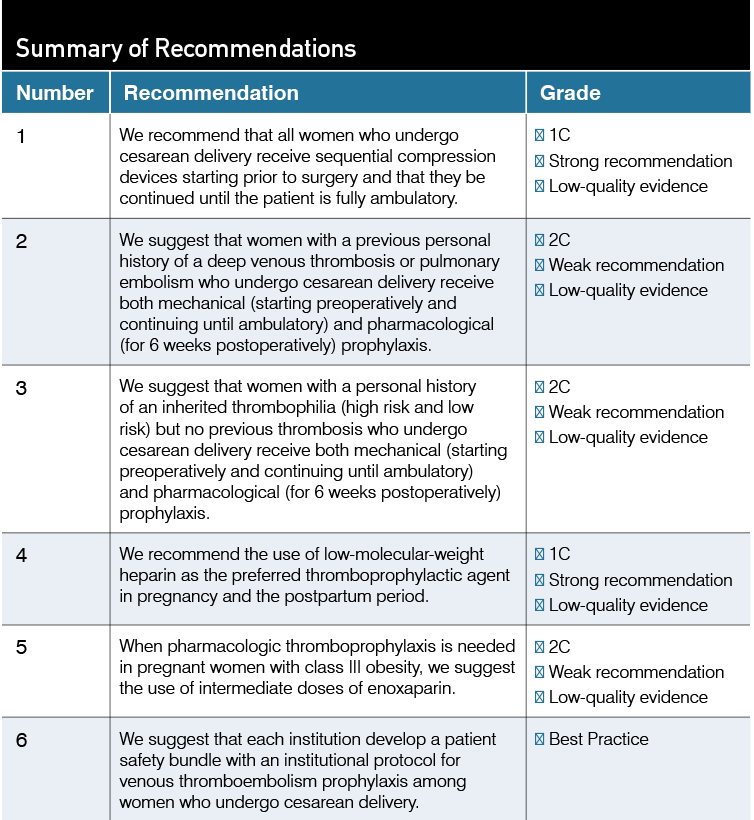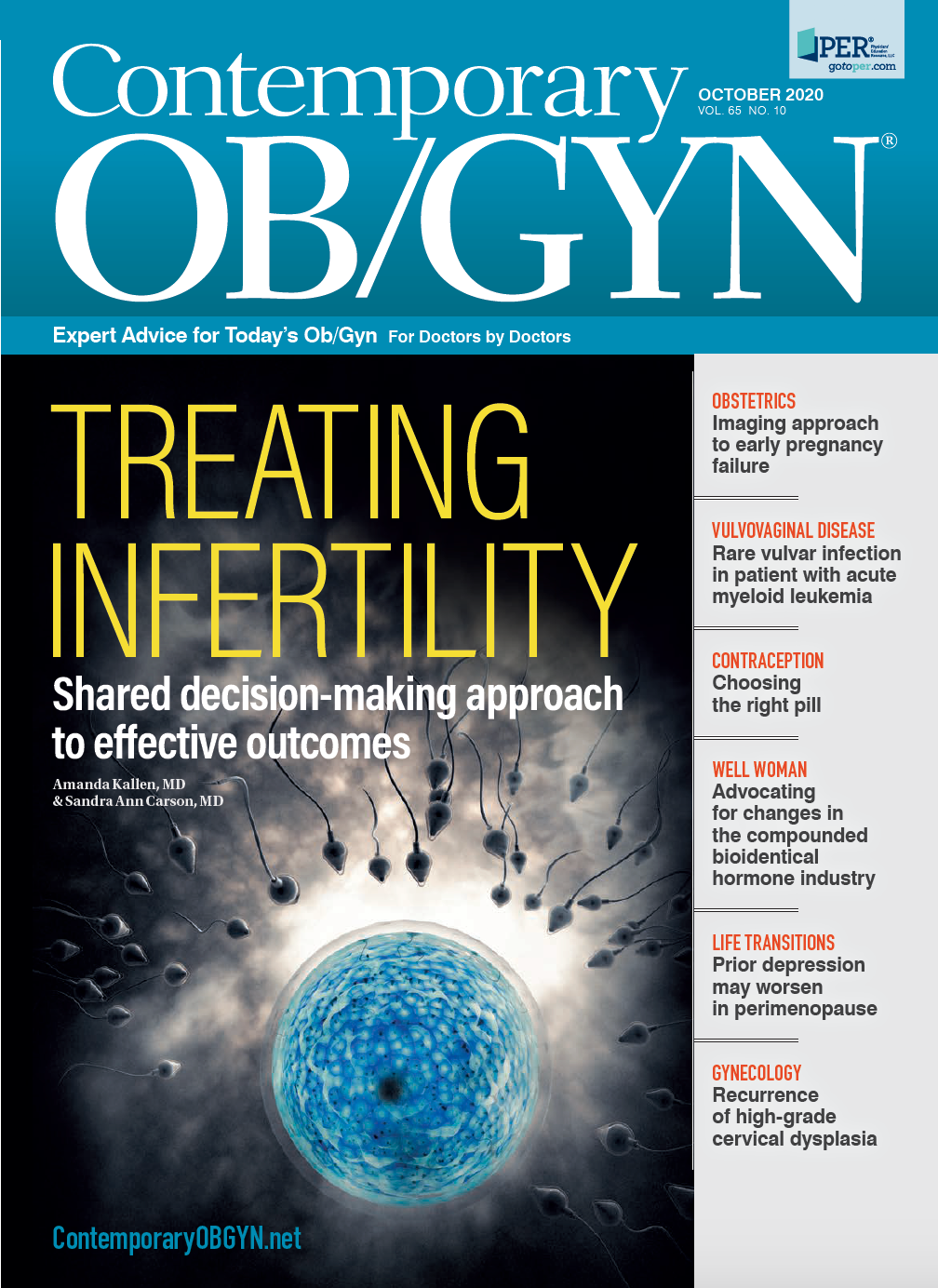Society for Maternal-Fetal Medicine Consult Series #51: Thromboembolism prophylaxis for cesarean delivery
The risk of venous thromboembolism is particularly high during the postpartum period and especially following cesarean delivery.
Venous thromboembolism (VTE) is a major cause of maternal morbidity and mortality. The estimated incidence of VTE during pregnancy and the postpartum period is 1 to 2 per 1,000 deliveries.1 The risk of VTE is particularly high during the postpartum period and especially following cesarean delivery.
There is considerable variation in the approach to VTE prophylaxis in pregnancy, including following cesarean delivery. Recent guidelines by various professional organizations provide conflicting recommendations based on low-grade evidence, mainly from observational data.
At present, the available VTE risk stratification tools used to decide for or against pharmacological prophylaxis have not been validated in women undergoing cesarean delivery. Individualization of care is recommended for women at very high risk of VTE.
Q| What are the current guidelines for VTE prophylaxis following cesarean delivery?
Several guidelines define risk factors for VTE, including those summarized in Table 1 from the American College of Chest Physicians (ACCP), Royal College of Obstetricians and Gynaecologists (RCOG), and National Partnership for Maternal Safety (NPMS).
Table 1. Current guidelines on thromboembolism prophylaxis after cesarean delivery

The American College of Obstetricians and Gynecologists (ACOG) recommends that all women undergoing a cesarean delivery receive mechanical prophylaxis with the use of pneumatic sequential compression devices started preoperatively and continued until the patient is ambulatory.2
The use of combined pharmacological and mechanical prophylaxis may also be supported based on individual risk assessment. ACOG does not endorse any specific risk stratification guidelines. Hospitals are encouraged to evaluate women for VTE risk factors and to implement a prophylaxis protocol weighing benefits, harms, and cost-effectiveness. If VTE risk factors persist during the postpartum period, up to 6 weeks of pharmacological prophylaxis should be considered.
The ACCP suggests that the benefits of thromboprophylaxis outweigh potential harm when the absolute risk of VTE is 3% or higher.3 The presence of 1 major risk factor, 1 minor risk factor in the setting of an emergent cesarean delivery, or 2 or more minor risk factors suggests a VTE risk above 3%.
For women undergoing cesarean delivery with no risk factors for VTE, ACCP recommends no prophylaxis other than early mobilization.
In women at very high risk for VTE, combined pharmacological and mechanical prophylaxis is suggested. If VTE risk factors persist during the postpartum period, up to 6 weeks of prophylaxis is suggested.
The RCOG recommends thromboprophylaxis with low-molecular-weight heparin (LMWH) for 10 days after delivery should be considered for all women who have had cesarean sections and those having an elective cesarean section who have any additional risk factors.4 Prophylaxis with LMWH is recommended for 10 days following delivery in intermediate-risk women and for at least 6 weeks following delivery in high-risk women.
The NPMS recommends universal pneumatic compression devices for all women undergoing cesarean deliveries.5
The addition of pharmacological prophylaxis may be considered for women at high risk of VTE based on the use of either the RCOG guidelines or the modified Caprini scoring system. Hospitals may consider providing pharmacological VTE prophylaxis to all women undergoing a cesarean delivery because of the challenges in consistently identifying women with VTE risk factors.
Q| Is there sufficient evidence to recommend one specific guideline over the other?
In general, all women with a previous episode of VTE require prophylactic doses of LMWH or unfractionated heparin (UFH) for at least 6 weeks postpartum. Women with no previous personal history of VTE but who have tested positive for one of the high-risk inherited thrombophilias (antithrombin III deficiency, homozygous Factor V Leiden or G20210A, or heterozygous for both Factor V Leiden and G20210A) or who have a low-risk thrombophilia should also receive pharmacological VTE prophylaxis following cesarean delivery.
Women with a previous diagnosis of antiphospholipid antibody syndrome should receive prophylactic or therapeutic doses of heparin (depending on previous history of VTE) during the puerperium irrespective of mode of delivery.
The main discrepancy among current guidelines concerns pharmacologic prophylaxis for women with no history of VTE and no inherited or acquired thrombophilia. Recommendations differ in part because they are based on observational studies and expert opinion due to a lack of clinical trial data.
This presents a challenge for determining the true incidence of VTE and accurately assessing the risk-benefit ratio of pharmacological prophylaxis following cesarean delivery. The potential benefit of pharmacological prophylaxis needs to be weighed against the potential for adverse outcomes associated with the intervention.
For instance, the use of pharmacological VTE prophylaxis following cesarean delivery has been associated with increased rates of wound separation and wound hematomas. In the absence of adequately powered clinical trials, accurate calculations of the number needed to treat (NNT) and number needed to harm (NNH) are limited.
However, the available evidence suggests that the NNH may be lower than the NNT in most scenarios, particularly in the absence of risk factors or the presence of only a minor risk factor.
Further, administrative and retrospective data obtained from analysis of large databases may overestimate the incidence of VTE, resulting in a similar overestimation of the benefit of any intervention aimed at preventing it.
Another consideration in making recommendations is that the use of risk assessment models (eg, Caprini and Padua) to predict VTE following cesarean delivery has not been adequately studied.
The authors of a recent study questioning their utility during the peripartum period suggest the establishment of a maternal clinical registry and more extensive research to identify optimal models with which to predict VTE risk in the obstetrical population.6
At present, the available evidence to suggest that universal (or near universal) pharmacological VTE prophylaxis effectively reduces maternal mortality is limited.7 Any attributable benefit of universal pharmacological VTE prophylaxis after cesarean delivery in maternal mortality will likely be low due to the rarity of the event.
A recent study reported only 1 maternal death from VTE among 465,880 women undergoing a cesarean delivery when all women received mechanical prophylaxis (eg, sequential compression devices).8
Q| Which pharmacological agents are commonly used for prophylaxis of venous thromboembolism?
The two most common agents used for VTE prophylaxis are LMWH and UFH. Current guidelines recommend LMWH (eg, enoxaparin) as the first-line pharmacological agent.2,3
Enoxaparin is not recommended in patients with significant renal dysfunction, defined as creatinine clearance less than 30 mL/min.
Compared with UFH, enoxaparin has the advantage of better bioavailability, longer half-life, more predictable anticoagulation effect, less bleeding risks, and less risk of heparin-induced thrombocytopenia and osteopenia.
For prophylaxis purposes, the recommended enoxaparin dosage is typically 40 mg subcutaneously once a day. Obese women may require higher doses; however, the optimal dose is unknown. Some evidence supports the use of intermediate doses of enoxaparin (40 mg subcutaneously every 12 hours) for obese women.
UFH is a good choice in women with renal disease. Recommended prophylactic dosages range from 5000 to 10,000 units subcutaneously every 12 hours depending on gestational age (5000 units subcutaneously every 12 hours in the first trimester, 7500 units subcutaneously every 12 hours in the second trimester, and 10,000 units subcutaneously every 12 hours during the third trimester).
In the postpartum period, doses of 5000 units subcutaneously every 8–12 hours are commonly utilized. There are insufficient data to recommend the use of new oral anticoagulants (eg, apixaban, rivaroxaban, dabigatran) during the postpartum period.
Q| When is the optimal time to start thromboembolism prophylaxis after a cesarean delivery?
Current ACOG guidelines recommend starting VTE mechanical prophylaxis with sequential compression devices preoperatively in all women undergoing a cesarean delivery.2
The Society for Obstetric Anesthesia and Perinatology (SOAP) has addressed the optimal interval between neuraxial anesthesia and initiation of VTE pharmacological prophylaxis to prevent development of spinal or epidural hematomas.9
Prophylactic doses of enoxaparin (40 mg subcutaneously every day) may be started postoperatively as soon as 4 hours after catheter removal but not earlier than 12 hours after the block was performed. Intermediate doses of enoxaparin (40 mg subcutaneously every 12 hours) and therapeutic doses may also be started as soon as 4 hours after catheter removal but not earlier than 24 hours after the block was performed. Prophylactic doses of UFH may be started as early as 1 hour after removal of the neuraxial catheter.
In addition to concerns about spinal hematomas, timing to start VTE prophylaxis should also consider the risk of postoperative bleeding.
With prophylactic doses of anticoagulation, bleeding complications are usually mild and rarely result in life-threatening hemorrhage, unlike bleeding risks with the use of full-dose anticoagulation in the postoperative period.
In cases with significant intraoperative bleeding complications, the decision of when to start pharmacological prophylaxis (if indicated) must be individualized, while recognizing that postpartum hemorrhage, blood transfusion, and prolonged surgery are risk factors for VTE. In these cases, initiation of UFH, which is reversible and has a shorter half-life, may be prudent.
Conclusion
VTE remains an important cause of maternal morbidity and mortality during pregnancy and the postpartum period.
The use of mechanical prophylaxis sequential compression devices is an inexpensive, safe intervention and should be used in all women undergoing cesarean delivery until the woman is fully ambulatory.
The decision to add pharmacological prophylaxis depends on the presence or absence of certain risk factors. Women with a previous personal history of deep venous thrombosis or pulmonary embolism and women with a personal history of an inherited thrombophilia should receive pharmacological prophylaxis following cesarean delivery.
The use of universal or near-universal pharmacological prophylaxis for women undergoing cesarean delivery, other than those with a previous thrombosis or an inherited thrombophilia, cannot be recommended until further studies demonstrate that such a strategy is beneficial.
Summary of recommendations

Created in partnership with the Society for Maternal-Fetal Medicine. SMFM was established in 1977 to “give Maternal-Fetal Medicine (MFM) physicians and scientists a place to share knowledge, research and clinical best practices in order to improve care for moms and babies.”
__
References
- Rodger M. Pregnancy and venous thromboembolism: 'TIPPS' for risk stratification. Hematology American Society of Hematology Education Program 2014;2014:387-92.
- American College of Obstetricians and Gynecologists. ACOG Practice Bulletin No. 196: Thromboembolism in Pregnancy. Obstetrics and gynecology 2018;132:e1-e17.
- Bates SM, Greer IA, Middeldorp S, Veenstra DL, Prabulos AM, Vandvik PO. VTE, thrombophilia, antithrombotic therapy, and pregnancy: Antithrombotic Therapy and Prevention of Thrombosis, 9th ed: American College of Chest Physicians Evidence-Based Clinical Practice Guidelines. Chest 2012;141:e691S-e736S.
- Reducing the risk of venous thromboembolism during pregnancy and the puerperium. Green-top Guideline No. 37a. (Accessed February 4, 2019, at https://www.rcog.org.uk/en/guidelines-research-services/guidelines/gtg37a/.)
- D'Alton ME, Friedman AM, Smiley RM, et al. National Partnership for Maternal Safety: Consensus Bundle on Venous Thromboembolism. Obstetrics and gynecology 2016;128:688-98.
- Tran JP, Stribling SS, Ibezim UC, et al. Performance of Risk Assessment Models for Peripartum Thromboprophylaxis. Reprod Sci 2018:1933719118813197.
- Bain E, Wilson A, Tooher R, Gates S, Davis LJ, Middleton P. Prophylaxis for venous thromboembolic disease in pregnancy and the early postnatal period. The Cochrane database of systematic reviews 2014:Cd001689.
- Clark SL, Christmas JT, Frye DR, Meyers JA, Perlin JB. Maternal mortality in the United States: predictability and the impact of protocols on fatal postcesarean pulmonary embolism and hypertension-related intracranial hemorrhage. American journal of obstetrics and gynecology 2014;211:32.e1-9.
- Leffert L, Butwick A, Carvalho B, et al. The Society for Obstetric Anesthesia and Perinatology Consensus Statement on the Anesthetic Management of Pregnant and Postpartum Women Receiving Thromboprophylaxis or Higher Dose Anticoagulants. Anesthesia and analgesia 2018;126:928-44.

S4E1: New RNA platform can predict pregnancy complications
February 11th 2022In this episode of Pap Talk, Contemporary OB/GYN® sat down with Maneesh Jain, CEO of Mirvie, and Michal Elovitz, MD, chief medical advisor at Mirvie, a new RNA platform that is able to predict pregnancy complications by revealing the biology of each pregnancy. They discussed recently published data regarding the platform's ability to predict preeclampsia and preterm birth.
Listen
Racial disparities based on delivery hospital quality reported
March 24th 2025A new study found that Black and American Indian birthing individuals in the United States are more likely to deliver at lower-quality hospitals than White patients, highlighting systemic health care inequities.
Read More
sFLT1/PLGF ratio may improve risk stratification for birth outcomes
March 17th 2025A recent study suggests that the soluble fms-like tyrosine kinase 1 to placental growth factor ratio can help predict clinical deterioration, intrapartum fetal distress, and mode of delivery, offering valuable insights for patient counseling and labor management.
Read More
